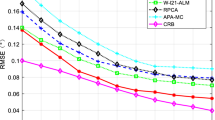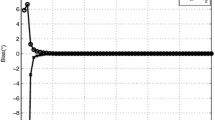Abstract
It is known that the performance of classical direction-of-arrival (DOA) estimators may be deteriorated considerably in the presence of non-uniform noise and low signal-to-noise ratio (SNR). Focusing on this issue, based on the matrix completion theory, a sparse reconstruction algorithm combining second-order statistical vectors and weighted L1-norm is developed in this paper. In the proposed method, the elastic regularization factor is firstly introduced into the matrix completion model to reconstruct the signal covariance matrix as a noise-free covariance matrix. In what follows, the obtained multi-vector issue associated with the noise-free covariance matrix can be recast as a single vector one by exploiting matrix sum-average operation in the second-order statistical domain. With the constructed single vector, DOA estimation can be complemented by employing the sparse reconstruction weighted L1-norm (WL1) approach. Numerical simulation results show that the proposed algorithm has improved angle estimation accuracy and resolution effectively under low SNR and can suppress the effect of noise non-uniformity significantly.






Similar content being viewed by others
References
J.F. Cai, E.J. Candes, Z. Shen, A singular value thresholding algorithm for matrix completion. SIAM J. Optim. 20(4), 1956–1982 (2010)
E.J. Candes, Y. Plan, Matrix completion with noise. Proc. IEEE 98(6), 925–936 (2009)
E.J. Candes, B. Recht, Exact matrix completion via convex optimization. Found. Comput. Math. 9(6), 717–772 (2009)
E.J. Candes, M.B. Wakin, S.P. Boyd, Enhancing sparsity by reweighted L1 minimization. J. Fourier Anal. Appl. 14(5), 877–905 (2008)
H. Ghanbari, H. Zayyani, E. Yazdian, Joint DOA estimation and array calibration using multiple parametric dictionary learning. arXiv: 1707.07299
M. Grant, S. Boyd, CVX: matlab software for disciplined convex programming 2013. http://www.cvxr.com/cvx. Accessed Aug 2013
Z.Q. He, Z.P. Shi, L. Huang, Covariance sparsity-aware DOA estimation for nonuniform noise. Digit. Signal Process. 28(1), 75–81 (2014)
R.A. Horn, C.R. Johnson, Matrix Analysis (Cambridge University Press, Cambridge, 1985)
R. Hu, Y. Fu, Z. Chen, J.W. Xu, J. Tang, Robust DOA estimation via sparse signal reconstruction with impulsive noise. IEEE Commun. Lett. 21(6), 1333–1336 (2017)
X. Jiang, Z. Zhong, X. Liu, H.C. So, Robust matrix completion via alternating projection. IEEE Signal Process. Lett. 24(5), 579–583 (2017)
B. Liao, S.C. Chan, L. Huang, C. Guo, Iterative methods for subspace and DOA estimation in nonuniform noise. IEEE Trans. Signal Process. 64(12), 3008–3020 (2016)
B. Liao, C. Guo, L. Huang, J. Wen, Matrix completion based direction-of-arrival estimation in nonuniform noise, in Proc. 20th IEEE International Conference on Digital Signal Processing (2016), pp. 66–69
B. Liao, L. Huang, C. Guo, H.C. So, New approaches to direction-of-Arrival estimation with sensor arrays in unknown nonuniform noise. IEEE Sens. J. 16(24), 8982–8989 (2016)
M. Lobo, L. Vandenberghe, S. Boyd, H. Lebret, Application of second-order cone programming. Linear Algebra Appl. 284(1–3), 193–228 (1998)
D. Malioutov, M. Cetin, A.S. Willsky, A sparse signal reconstruction perspective for source localization with sensor arrays. IEEE Trans. Signal Process. 53(8), 3010–3022 (2005)
S. Mao, L. Xiong, L. Jiao, T. Feng, S.K. Yeung, A novel riemannian metric based on riemannian structure and scaling information for fixed low-rank matrix completion. IEEE Trans. Cybern. 47(5), 1299–1312 (2017)
B. Ottersten, P. Stoica, R. Roy, Covariance matching estimation techniques for array signal processing applications. Digit. Signal Process. 8(3), 185–210 (1998)
P. Pal, P.P. Vaidyanathan, A grid-less approach to underdetermined direction of arrival estimation via low rank matrix denoising. IEEE Signal Process. Lett. 21(6), 737–741 (2014)
M. Pesavento, A.B. Gershman, Maximum-likelihood direction-of-arrival estimation in the presence of unknown nonuniform noise. IEEE Trans. Signal Process. 49(7), 1310–1324 (2002)
R. Schmidt, Multiple emitter location and signal parameter estimation. IEEE Trans. Antennas Propag. 34(3), 276–280 (1986)
R. Sun, Z.Q. Luo, Guaranteed matrix completion via non-convex factorization. IEEE Trans. Inf. Theory 62(11), 6535–6579 (2016)
S. Sun, A.P. Petropulu, Waveform design for MIMO radars with matrix completion. IEEE J. Sel. Top. Signal Process. 9(8), 1400–1414 (2015)
Y. Tian, H. Shi, H. Xu, DOA estimation in the presence of unknown nonuniform noise with coprime array. Electron. Lett. 53(2), 113–115 (2016)
Y. Tian, X. Sun, S. Zhao, DOA and power estimation using a sparse representation of second-order statistics vector and L0-norm approximation. Signal Process. 105, 98–108 (2014)
H.L. Van Trees, Detection, Estimation, and Modulation Theory, Optimum Array Processing, Part IV (Wiley, New York, 2002)
B. Wang, Y. Gu, W. Wang, Off-grid direction-of-arrival estimation based on steering vector approximation. Circuits Syst. Signal Process. 38(3), 1287–1300 (2019)
J. Yang, Y. Yang, G. Liao, B. Lei, A super-resolution direction of arrival estimation algorithm for coprime array via sparse bayesian learning inference. Circuits Syst. Signal Process. 37(5), 1907–1934 (2018)
J.H. Yin, T.Q. Chen, Direction-of-arrival estimation using a sparse representation of array covariance vectors. IEEE Trans. Signal Process. 59(9), 4489–4493 (2011)
H. Zamani, H. Zayyani, F. Marvasti, An iterative dictionary learning-based algorithm for DOA estimation. IEEE Commun. Lett. 20(9), 1784–1787 (2016)
Acknowledgements
This work is partially supported by the National Natural Science Foundation of China under Grant 61301258, 61271379, China Postdoctoral Science Foundation Funded Project under Grant No. 2016M590218 and the 111 Project (B18039).
Author information
Authors and Affiliations
Corresponding author
Additional information
Publisher’s Note
Springer Nature remains neutral with regard to jurisdictional claims in published maps and institutional affiliations.
Appendix: The Selection of η
Appendix: The Selection of η
The vectorization of the estimate error of the noise-free covariance matrix denoted by \( \Delta {\mathbf{R}}_{0} \varvec{ = }{\hat{\mathbf{R}}}_{0} \varvec{ - }{\mathbf{R}}_{0} \) is subject to the following distribution [17]:
where \( \text{AsN}\left( \cdot \right) \) denotes the asymptotically normal distribution and \( {\hat{\mathbf{R}}}_{0} \) can be obtained by solving (18).
As illustrated above, the vector \( {\varvec{\Upsilon}} \) can be obtained by using sum-average operation on \( {\mathbf{R}}_{0} \). Consequently, it indicates a linear relationship between \( \Delta {\varvec{\Upsilon}} \) and \( \text{vec}\left( {\Delta {\mathbf{R}}_{0} } \right) \), i.e.,
where \( {\hat{\mathbf{\varvec{\Upsilon}}}} \) is the \( {\varvec{\Upsilon}} \) estimate with \( L \) snapshots, \( {\mathbf{G}} \in \left( {2M - 1} \right) \times M^{2} \) is a linear transformation matrix, and \( \text{rank}\left( {\mathbf{G}} \right) = 2M - 1 \) [24].
Combining (30) and (31), we have:
that is, \( {\hat{{\varvec{\Upsilon}}}} - {\tilde{\mathbf{B}}}\left( {\varvec{\Psi}} \right){\tilde{\mathbf{P}}} \) satisfies the asymptotically normal distribution with mean 0 and variance \( \frac{1}{L}{\mathbf{G}}\left( {{\mathbf{R}}_{0}^{T} \otimes {\mathbf{R}}_{0} } \right){\mathbf{G}}^{T} \).
Furthermore, (32) indicates that
where \( {\mathbf{H}}^{{{{ - 1} \mathord{\left/ {\vphantom {{ - 1} 2}} \right. \kern-0pt} 2}}} \) is the Hermitian square root of \( {\mathbf{H}}^{{{ - }1}} \),
According to the normal distribution theory, (33) can be reshaped as:
where \( {As\chi }^{2} \left( {2M - 1} \right) \) denotes the asymptotic Chi-square distribution with \( 2M - 1 \) degrees of freedom.
Following (35), the error parameter factor \( \eta \) can be obtained properly by the Chi-square distribution function with probability \( 1 - \bar{p} \) and \( 2M - 1 \) degrees of freedom, where \( \bar{p} \) is a probability value. In general, \( \bar{p} \) is generally determined by simulation experiments [24]. With the analysis in [24], \( \bar{p} = 0.01 \) would be an acceptable compromise.
Rights and permissions
About this article
Cite this article
Fang, Y., Wang, H., Zhu, S. et al. Reconstructing DOA Estimation in the Second-Order Statistic Domain by Exploiting Matrix Completion. Circuits Syst Signal Process 38, 4855–4873 (2019). https://doi.org/10.1007/s00034-019-01093-2
Received:
Revised:
Accepted:
Published:
Issue Date:
DOI: https://doi.org/10.1007/s00034-019-01093-2




